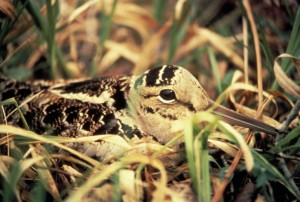Last Saturday afternoon was a gorgeous autumn afternoon across Western North Carolina. Last Saturday morning, however, when Bob Olthoff and I had a play date to do some birding at Tessentee Bottomland Preserve, it was socked-in, cold and damp. Birds were hunkered down and quite, except for the crows. We still managed a respectable 32 species for the two-and-a-half to three hours we spent there including great close-up views of an American woodcock and a red-shouldered hawk.
The Tessentee Bottomland Preserve, in southern Macon County along the confluence of Tessentee Creek and the Little Tennessee River is owned and managed by The Land Trust for the Little Tennessee. A recent purchase has expanded Tessentee to 70 acres. Tessentee offers a mixture of habitat including canebrake, wetlands, red cedar savannah, mixed oak/pine forest, brambles, a small area of old oaks and an old homestead. The Preserve is site number 53 in the North Carolina Birding Trail’s Mountain Guide. It offers excellent birding, especially during spring and fall migration and is a great place to go sparrowing in the winter.
We stumbled upon a partially leucistic dark-eyed junco in the woods along the entrance road, just before the old homestead. The plumage was standard junco – gray back and tail with white outer tail coverts – except for the head, which was mostly white with a dark crown and dark smudges on the sides. Dark-eyed juncos are known to hybridize with sparrows like song sparrows and white-throated sparrows and the fact that this bird was alone except for some nearby sparrow companions definitely piques the curiosity. But the fact the rest of the plumage, except for the head, was so typically junco points to leucism. At any rate, the bird didn’t hang around for lengthy observation and from what I saw I’m ticking it off as a leucistic junco.
As we approached the old homestead, some raptor-like movement caught my eye. After scanning the woods near the old home we finally found an immature red-shouldered hawk perched a few feet from the ground, focused intently on a small brush pile. We didn’t want to disturb the bird’s breakfast so we headed down a different trail towards the river.
As I noted earlier, birds were hunkered down and quite, but if you found a little activity you could generally find and/or entice a mixed flock. After we left the red-shouldered we first heard a towhee, then heard and saw a few Carolina chickadees foraging. We soon realized there were kinglets mixed in – a little pishing and voila, the brambles erupted with white-crowned and song sparrows. A couple of hermit thrushes were also discovered.
And that’s the way the morning went. We would walk along in the fog till a chip note or some movement would alert us and then some investigation and pishing would usually result in flushing a group of birds. At one point on the trail alongside the river we were investigating some movement in a woodpile when a woodcock flushed from next to the trail. It hovered over the trail less than 20 feet from us, giving great views.
We got all the usual sparrows – song, white-throated, white-crowned, junco, field and swamp – except for fox sparrow. I feel sure they were there, they generally are we just didn’t bump into the right group of birds.
By the time we had to leave, almost noon, the sun began to burn away the fog and blue skies began to shine through. At the car we had flyovers by killdeer and common grackles, trying to entice us to stay but commitments beckoned. We will be back, however, and if you’re looking for some good winter birding you should put Tessentee on your list.
To get to Tessentee Bottomland Preserve take Riverside Road off US 23/441, 5.2 miles south of Franklin. Follow Riverside for 0.5 miles to its end. Turn right on Hickory Knoll Road and follow it for 1.8 miles. Turn right at 2249 Hickory Knoll Road. There is a sign on Hickory Knoll Road indicating Tessentee Bottomland Preserve on your right; the red farm gate to the left, as you enter, is the entrance to the property.

